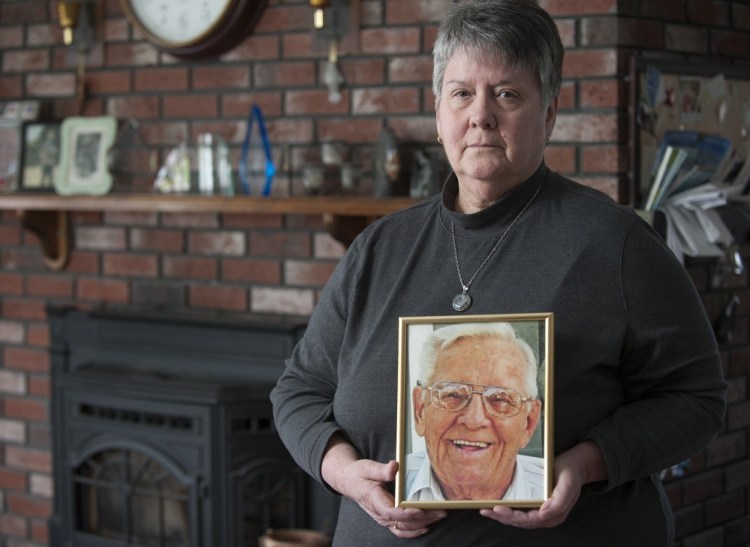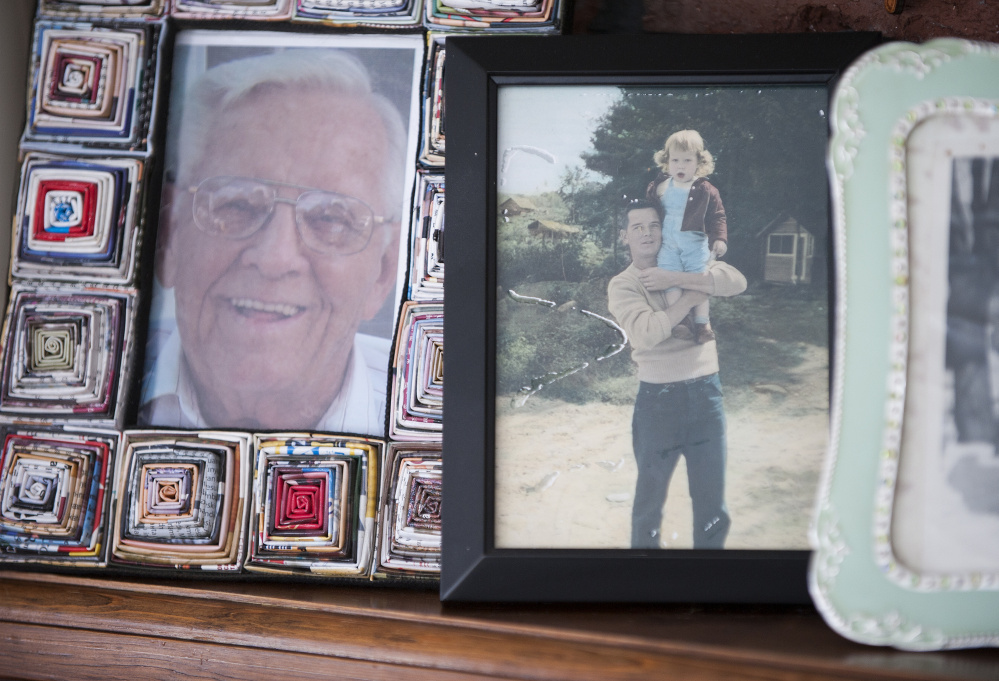Kathy Day could only watch helplessly as her father’s health deteriorated from a drug-resistant staph infection he acquired at Millinocket Regional Hospital, where he had gone to rehabilitate a broken ankle in 2009.
Her father, John McCleary Sr., died three weeks after he was discharged.
“He was never able to stand again. I watched him die,” said Day, 67, a retired nurse from Bangor. “I was angry and disappointed. It really hurt to know this could happen.”
She said that although her father was 83 when he died, he was in relatively good health and his death was avoidable. Day said she filed a lawsuit against the hospital, but it was quickly withdrawn.
Day has become an advocate for patient safety, serving on the state Healthcare Associated Infections Council – which works to reduce medical errors in hospitals that lead to infections – and giving patient safety presentations to health professionals and students at the University of Southern Maine, among other advocacy work.
“There’s a big lack of awareness,” Day said.
THIRD-LEADING CAUSE OF DEATH
Medical errors such as infections at hospitals are the third-leading cause of death in the United States, behind heart attacks and cancer, according to a Johns Hopkins University study released this week.
The study estimated that 250,000 people die from medical errors each year. That’s a more precise figure but within the range of a study published in 2013 in the Journal of Patient Safety by other researchers, who concluded that medical errors killed between 210,000 and 440,000 people annually.
Both estimates are far higher than an original estimate by the Institute of Medicine in 1999 suggesting that the death range from medical errors was between 44,000 and 98,000 per year. That’s comparable to the deaths caused by influenza, diabetes or Alzheimer’s disease, and would make medical errors the sixth, seventh or eighth leading cause of death.
The estimates are based on mathematical models, as actual data on medical errors causing death are incomplete. The lack of data was noted by Johns Hopkins researchers, who called for reforms such as routinely listing medical errors on death certificates, to generate more precise information.
Dr. Robert Wachter, a professor of medicine at the University of California, San Francisco, and national expert on patient safety, emphasized the poor quality of data on medical errors. He said the Johns Hopkins study was flawed, and that “nobody knows” the number of deaths caused by medical errors.
“(The study) basically averaged a bunch of prior studies of questionable methodology to come out with a new estimate,” Wachter wrote in an email to the Portland Press Herald. “I don’t think it is any more scientifically sound than the original Institute of Medicine estimate of 44,000 to 98,000.”
TOO MANY ERRORS
Day said there’s a huge gap in the data, and that medical errors are “not being documented accurately and consistently.”
However, Wachter said the number of medical errors is too high – a sentiment that Maine health experts agreed with.
“Whether the absolute number of deaths is 250,000 or a much lower number doesn’t ultimately matter,” said Jeff Austin, vice president of government affairs at the Maine Hospital Association. “Medical errors occur and their causes need to be discussed and understood so that they can hopefully be eliminated.”
Emily Brostek, executive director of Consumers for Affordable Health Care, an Augusta-based public health advocacy group, said errors are an under-the-radar cause of death that should get more attention.
“It’s so common, but people don’t know about it unless it happens to them or someone they know. It doesn’t get the outrage,” Brostek said.
Dr. Dora Anne Mills, vice president of clinical affairs at the University of New England and a former director of the Maine Center for Disease Control and Prevention, said regardless of the number, more reforms are needed to improve patient safety.
“This is one of the biggest public health problems we have. People who go into health care do it generally because they want to help others. The people are good, people’s intentions are good, but the system is broken,” Mills said.
POOR TEAMWORK
She said one major concern is a lack of communication among professional staff, including doctors, nurses, pharmacists, physical therapists and others. For instance, one common problem is infections caused by catheters being in too long, which could be prevented simply by better communication.
“We are all educated and trained separately,” Mills said. “It would be like training all of the second basemen separately from third basemen and the outfielders, and then getting them all together on opening day and saying, ‘Play ball!’ What would happen? They wouldn’t be very good.”
Mills said that according to studies she’s seen, about 80 percent of medical error deaths are caused by poor teamwork among the medical staff.
She said when she trained to be a pediatrician in the 1980s, she never worked with nurses, so when she started practicing medicine, the medical jargon was different between nurses and doctors.
At UNE, Mills said, she’s in charge of coordinating interdisciplinary medical training, so doctors, nurses, therapists and others have experience working together before they graduate.
Brostek said the Affordable Care Act and Medicare have been pushing for better patient safety by offering incentives for hospitals that improve patient safety measures – such as reducing the number of hospital-acquired infections and preventable readmissions – and punishing those that resist making the changes.
While finding data on fatal medical errors is difficult, there’s a trove of information on patient safety. For instance, at Maine Medical Center in Portland, the hospital scored in the bottom 25 percent for hospitals on preventing certain common infections, but was among the best hospitals in the country for preventing avoidable readmissions. Overall, the Leapfrog Group, an independent rating agency, gives Maine’s hospitals high marks for patient safety, but seven other Maine hospitals joined Maine Med on the list of hospitals that performed poorly on preventing infections, including Central Maine Medical Center and MaineGeneral Medical Center.
REMINDER TO ‘PUSH HARDER’
Gordon Smith, executive vice president of the Maine Medical Association, an advocacy group representing physicians, said hospitals are taking strides to improve patient safety, especially over the past few years.
“There’s been a tremendous focus on patient safety and improving quality. You’re never going to get medical errors to zero,” Smith said. “There’s a tremendous amount of energy around improving those numbers.”
Austin said Maine hospitals “have long supported efforts to improve patient safety and quality.”
“But this study and others are good public reminders to always push harder for even better results,” Austin said in an email.
Day, the Bangor woman who lost her father to an infection, said more could be done, such as requiring hospitals to screen surgery patients as carriers of staph bacteria, and publishing more information on websites that compare hospitals, such as Leapfrog and www.comparemaine.org.
Day said patients could be more vigilant by bathing in chlorhexidine, a topical antibacterial antiseptic, before going to the hospital, as well as drinking lots of fluids and being extra cautious about washing hands.
She said that after her father’s death in 2009, she was initially angry with Millinocket Regional Hospital, but then realized that it was no better or worse than other hospitals.
“The more I learned, the more I realized this was happening everywhere,” Day said.
Send questions/comments to the editors.





Success. Please wait for the page to reload. If the page does not reload within 5 seconds, please refresh the page.
Enter your email and password to access comments.
Hi, to comment on stories you must . This profile is in addition to your subscription and website login.
Already have a commenting profile? .
Invalid username/password.
Please check your email to confirm and complete your registration.
Only subscribers are eligible to post comments. Please subscribe or login first for digital access. Here’s why.
Use the form below to reset your password. When you've submitted your account email, we will send an email with a reset code.